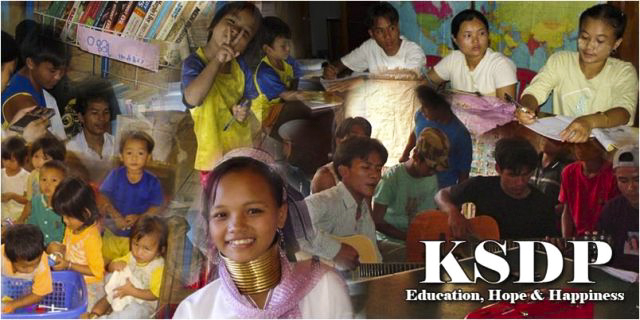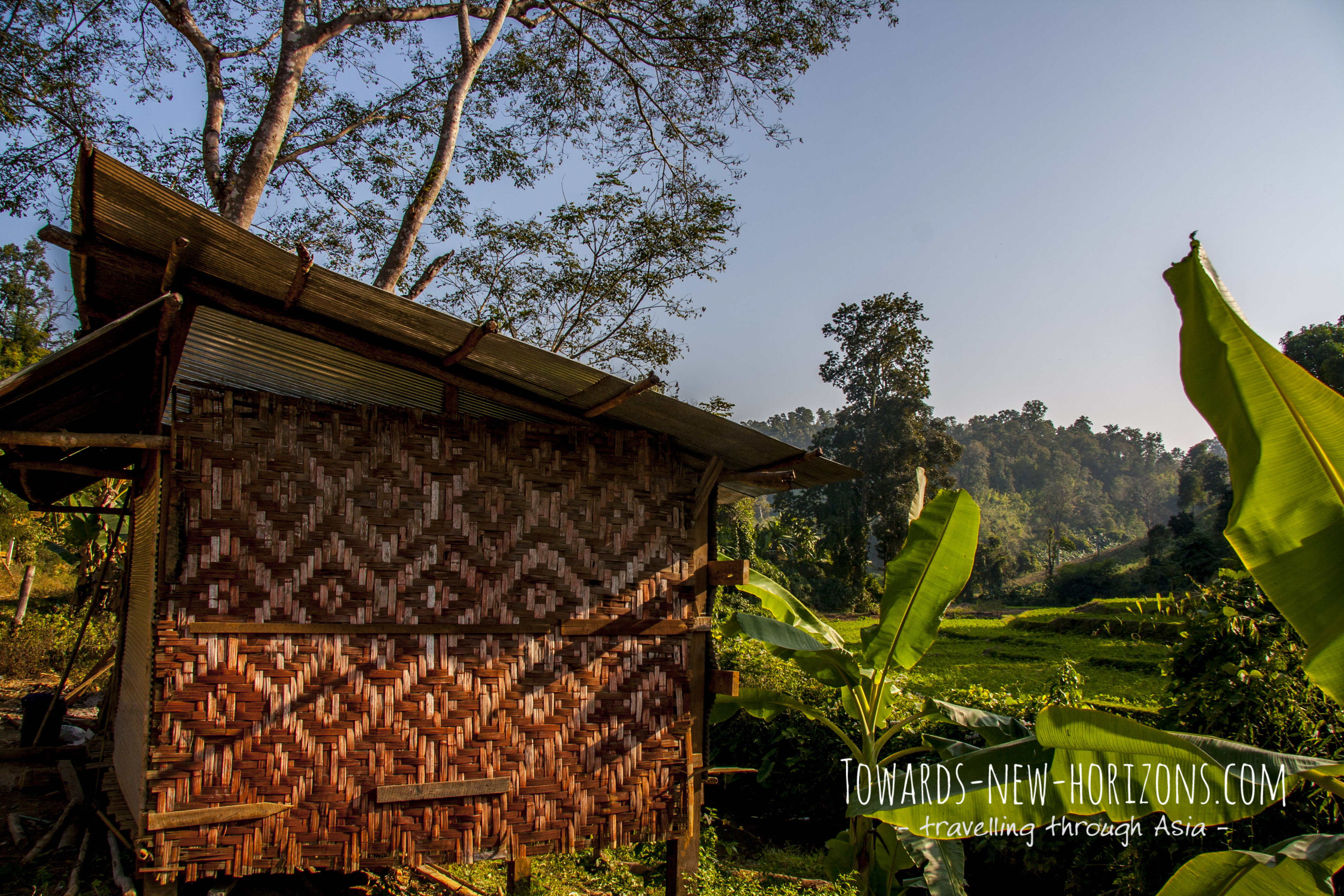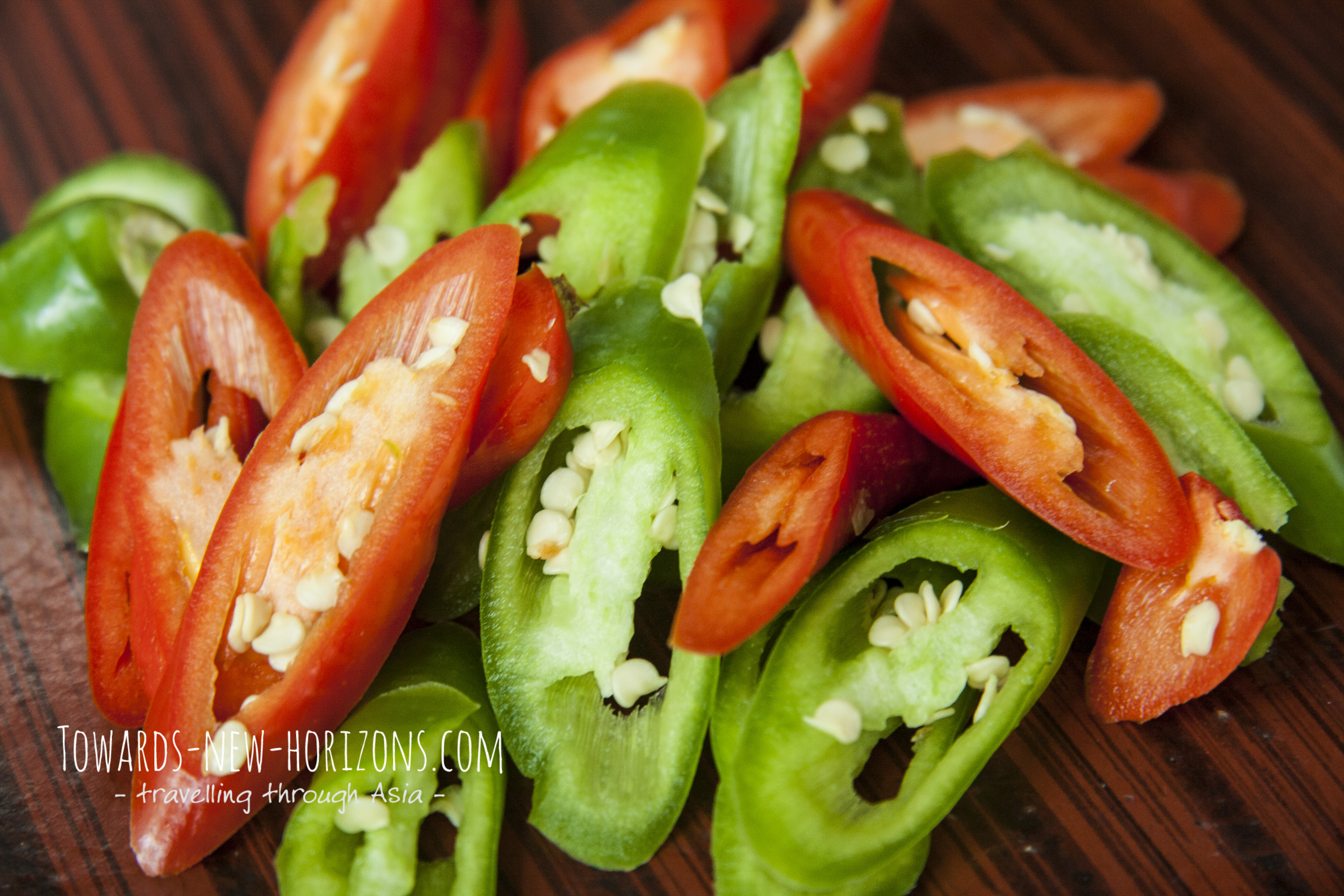Of all the cities we have seen so far in Thailand, Mae Hong Son I liked the most. It’s only a small place that radiates total coziness and yet offers some comfort to the fellow traveler… (read more)
Solo algunos pocos se animan a darse el palizón de ocho horas de autobús por las carreteras en algunos tramos más que tortuosas que separan Chiang Mai de Mae Hong Son, pero quien se decida a hacerlo se verá recompensado… (Continuar leyendo)
Von alle Städten die wir in Thailand bisher gesehen haben, hat mir Mae Hong Son bisher am besten gefallen. Es ist nur ein kleiner Ort der die totale Gemütlichkeit ausstrahlt… (Weiterlesen)
[fsg_gallery id=”77″]
Of all the cities we have seen so far in Thailand, Mae Hong Son I liked the most. It’s only a small place that radiates total coziness and yet offers some comfort to the fellow traveler. There are quite a few small homestays, but no large hotels dominate the scene. Due to the colorful tribes and cultures that mix here food is offered in great variety. Mae Hong Son exists in this form mostly because there were founded originally five camps for the Karenni / Burmese refugees – nowadays two exist. For this reason, numerous NGOs have, like in Mae Sot, settled here and the presence of their staff promises the merchants and restaurants a steady business. Even an airport was build, since the eight hour drive from Chiang Mai to Mae Hong Son apparently was too long and uncomfortable for many NGO employees.
However, while we now only wanted to get a quick bite after we came back from our trekking, we met Steve and Beryl, a British couple who run their own small aid organization called Karenni Student Development Programme (KSDP) here in Mae Hong Son. While eating together, we got to know their life story and the tragic reason for their impressive commitment. Their student daughter Stephanie was exploring northern Thailand about 15 years ago. By chance she heard about the refugee camps and the adverse conditions in which they lived. They are not allowed to leave the camps to look for work and so have to rely on aid. The plight of these refugees troubled their daughter strongly which is why she returned to England to organize, within just two months, supplies and donations. She returned and brought the aid to the Burmese refugees in the camps near to Mae Hong Son personally. There she began to live with the refugees, learned their language as well as Thai and taught English to the refugee children.
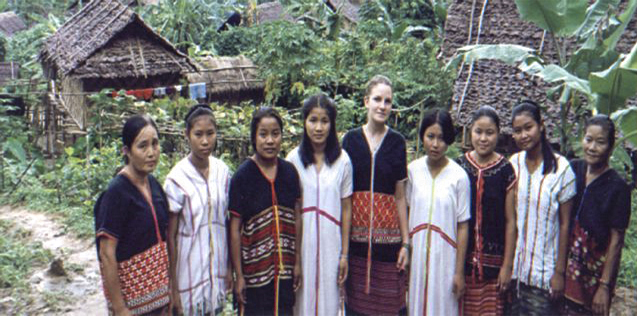
Tragically she was killed in a motorbike accident one night on the way home to camp. Her parents decided with a heavy heart to follow the presumed wishes of her daughter to be buried there, in the midst of the people which have meant so much to her. The funeral was quite a big event, because several thousand members of all the ethnic sub tribes in the camp were united in their grief and wanted to say goodbye personally and have an active part in the funeral. This was something which had never happened before.. Steve and Beryl have since taken on the task of continuing the admirable work of their daughter and run, with a lot of personal commitment, a foundation that brings desperately needed aid to the refugees. They fund projects that the larger NGOs do not address and try, with little to no bureaucracy in the way, to eliminate the needs of people who would otherwise have been overlooked.
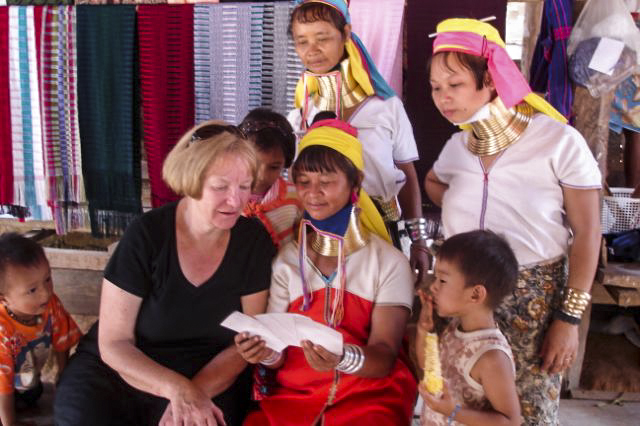
Together with Beryl & Steve the next day we left for Huay Pu Keng, a so-called Longneck Village that Thai also call Ban Nam Piang Din. Initially, we did not want to visit any of these villages, as they are under Thai control and were built exclusively for tourism. Members of the tribe of the Kayan, a sub-tribe of the Karenni people, which are so strikingly called ” Longneck”, were resettled from refugee camps in these places because of their tradition. There they serve as tourist valuable photographic objects which one can see after paying the 500 baht ( $ 16) admission – these villages have somewhat the character of a human zoo – supported by the irreverent manner in which some tourists want to get photographed together with the Kayan women. Due to the heavy metal rings around her neck, the shoulders are greatly depressed, which gives the impression of an extremely long neck – everyone has seen by now, such an image of a Kayan. The women are selling Thai souvenirs and get paid for wearing the rings theoretically 1500 baht a month, which is very little even for Thai standards, where the daily income is still at about 500 baht. But the Kayan woman who do not wear the rings do not get any money at all – but we have heard that even the ring wearing woman get their payment only occasionally, if at all. It happens often that if insufficient tourists come each month then the payment is off.
Together with Beryl and Steve and a Kayan man, who when a student was educated by their foundation, we went to Huay Pu Keng which we reached by a less used road to the village and via a brief boat ride over a river for 10 Baht. In this village are two school buildings which were constructed and maintained by the KSDP foundation.
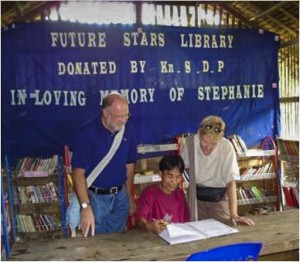
I had a particularly beautiful moment when I tried to play on a guitar like instrument. The Kayan lady sitting next to me showed me then, at my request, how to play this instrument and sang three songs for us. Although only for a brief moment, her voice and her songs were so beautiful, so different and mysterious that they moved me straight to tears.
The residents of the village also benefited from our visit since we bought a few of the self-woven scarves from different shops. These scarves are produced by the Kayan themselves and they can therefore keep the profit. All the rest of souvenirs: clothes, figures, scarves etc. are from Thailand and mass-produced and the Kayan get only a small proportion of the earnings.
For those of you in Mae Hong Son who are interested in visiting Huay Pu Keng Village on your own without the need of paying a guide or an entrance fee, we soon will put online a page with a map and detailed description on how to get there.
We thank Beryl and Steve for a wonderful experience that we would have missed without them. We have also learned a lot about the situation of camp refugees and the difficulties they have living there. Due to their relentless and completely voluntary commitment, we here refer to the website of their organization – www.ksdp.org.uk and invite everyone to learn more about their work and to support them. Their latest project is the construction of a clinic inside Burma where KSDP has paid for all the necessary construction material and the villagers will organise for free the actual construction.
Von alle Städten die wir in Thailand bisher gesehen haben, hat mir Mae Hong Son bisher am besten gefallen. Es ist nur ein kleiner Ort der die totale Gemütlichkeit ausstrahlt und dennoch für den Reisenden einiges an Komfort bietet. Es gibt ein paar kleine Homestays, keine großen Hotels, und das Essen bietet eine große Vielfalt durch den bunten Mix an Kulturen die hier zusammentreffen. Mae Hong Son existiert in dieser Form eigentlich nur weil es zwei Lager für burmesische Flüchtlinge (ursprünglich mal fünf) in der Umgebung gibt. Aus diesem Grund haben sich ähnlich wie in Mae Sot zahlreiche NGO’s hier angesiedelt und ihre Mitarbeiter versprechen den Händlern und Gastronomen ein ruhiges aber stetiges Geschäft. Sogar einen Flughafen gibt es hier wohl auch nur aus dem Grund, dass die achtstündige Anfahrt von Chiang Mai über zugegeben sehr kurvige Straßen den NGO lern wohl zu unangenehm und lang war.
Während wir nun also völlig erschlagen vom Trekking noch kurz etwas essen gehen wollen, treffen wir Steve und Beryl, ein britisches Ehepaar, die eine eigene kleine Hilfsorganisiation Karenni Student Development Programme (KSDP) hier in Mae Hong Son betreiben. Es war kein Tisch mehr frei und so haben wir uns zu ihnen gesetzt. Beim gemeinsamen Essen erfahren wir ihre Lebensgeschichte und den tragischen Grund für ihr beindruckendes Engagement in dieser Gegend. Ihre Tochter Stephanie war vor circa 15 Jahren in Nordthailand unterwegs und erfuhr per Zufall von den Flüchtlingscamps und den widrigen Bedingungen, mit denen die Burmesen in diesen Lagern zu kämpfen hatten. Die Thais haben, als immer die Flüchtlinge ins Land drängten diese in den Camps versorgt. Allerdings werden die Burmesen in diesen Camps festgehalten und daran gehindert sich Arbeit zu suchen, sie sind immer noch illegale Einwanderer in diesem Land. Das schwere Schicksal der Kriegsflüchtlinge beschäftigte ihre Tochter derart, dass sie kurzerhand nach England zurückgekehrt ist um innerhalb von nur 2 Monaten zahlreiche Hilfsgüter und Spenden zu organisieren, die sie persönlich zu den burmesischen Flüchtlingen nach Mae Hong Son begleitete. Dort wohnte sie seitdem und hat sich bei der thailändischen Führung für die Rechte der Flüchtlinge und deren Ausbildung eingesetzt.

Schrecklicherweise kam sie eines Nachts auf dem Heimweg zum Camp bei einem Motorradunfall ums Leben. Ihre Eltern entschieden schweren Herzens sie, entsprechend des vermutlichen Wunsches ihrer Tochter, dort beerdigen zu lassen in Mitten der Menschen die ihr so viel bedeutet haben. Die Beerdigung war ein regelrechtes Großereignis, denn mehrere tausend Angehörige aller dort lebenden Stämme waren in ihrer Trauer vereint und wollten Abschied nehmen. So etwas gab es bisher noch nie und laut Beryl führte es die verschiedenen Volksgruppen in den Camps näher zusammen.
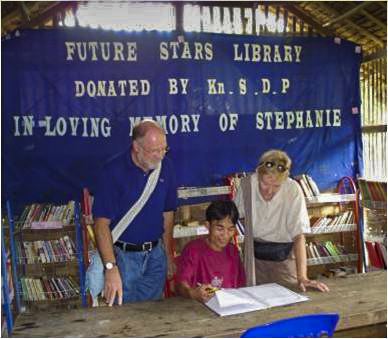
Steve und Beryl haben es sich seitdem zur Aufgabe gemacht, den so bewundernswerten Einsatz ihrer Tochter fortzuführen und leiten mit viel persönlichen Einsatz eine Stiftung die sich den Flüchtlingen annimmt. Dabei finanzieren sie Projekte die die größeren NGOs nicht angehen und versuchen so ganz unbürokratisch die Nöte der Menschen zu beseitigen, die sonst übersehen worden wären.
Gemeinsam mit den beiden sind wir am nächsten Tag aufgebrochen nach Huay Pu Keng, einem sogenannten Longneck Village. Wir wollten eigentlich keines dieser Dörfer besuchen, da sie unter thailändischer Kontrolle stehen und ausschließlich für den Tourismus gebaut wurden. Angehörige des Stammes der Kayan, einer Untergruppe des Volkes der Karreni, die so plakativ „Longneck“ genannt werden, wurden aus dem Flüchtlingscamps in diese Orte umgesiedelt. Dort dienen sie als touristisch wertvolles Fotoobjekt das man gegen 500 Baht (16 $) Eintritt p.P. besichtigen kann – so haben diese Dörfer schnell den Charakter eines menschlichen Zoos – gerade auch durch die respektlose Art und Weise wie die Touristen sich mit den Kayan Frauen ablichten lassen. Durch den schweren Metallring um ihren Hals werden die Schultern stark heruntergedrückt, was den Eindruck eines extrem langen Halses entstehen lässt – eigentlich jeder hat bereits Fotos einer Kayan Frau gesehen. Sie sind auch ein beliebtes und äußerst gewinnträchtiges Motiv für Postkarten oder Bücher, allerdings bekommt keine der abgelichteten Frauen dafür Geld beziehungweise hat je ihre Zustimmung gegeben, insofern sie denn um ihren “Ruhm” weiß.
Die Frauen sollen thailändische Souvenirs verkaufen und bekommen für das Tragen der Ringe theoretisch 1500 Baht im Monat, was auch für thailändische Maßstäbe sehr wenig ist, liegt doch das tägliche Einkommen bei circa 500 Baht. Kayan Frauen die die Halsringe nicht tragen bekommt gar kein Geld – das erhalten aber wie wir hören mussten Schmuck-tragende Frauen auch nur gelegentlich, wenn überhaupt. Denn es kommt wohl des öfteren vor, dass angeblich aufgrund zu weniger Besucher nicht gezahlt wird.
Gemeinsam mit Beryl und Steve und einem als Kind von ihrer Stiftung unterstützten Kayan, (er wollte sein Herkunftsdorf besuchen weil er mittlerweile in Australien lebt), sind wir über einen von Touristen kaum genutzten Weg zum Dorf gelangt. Zuletzt muss man noch kurz mit einem dorfeigenen kleinen Longboat für 10 Baht den Fluß zum Dorf überqueren. Dort haben uns die beiden zwei Schulgebäude gezeigt, dessen Bau und Unterhalt ihre Stiftung finanziert hat. Einen besonders schönen Moment hatte ich, als ich anstatt Fotos zu machen eine Kayan Frau bat mich an einem der ganz eigenen gitarrenähnlichen Instrumente versuchen zu dürfen. Nach einer Weile des Kennenlernens zeigte Sie mir auf meine Bitte hin wie man dieses Instrument spielt und stimmte 3 Lieder an. Der Klang und ihr Gesang waren so wunderschön, so andersartig und geheimnisvoll, dass sie mich glatt zu Tränen rührten. Ein unwirklicher Moment.

Damit die Bewohner im Dorf auch von unserem Besuch profitierten, kauften wir noch ein paar der selbstgewobenen Schals. Denn nur diese stellen die Kayan selbst her und behalten daher den Gewinn. Alles Übrige an Figuren, Kleidern, Anhängern, Schals etc. ist thailändische Massenware und die Kayan bekommen maximal einen kleinen Anteil.
Wenn ihr auch Interesse habt und dieses Dorf auf eigenen Fast besuchen wollt ohne dabei einem Tour Agent ausgeliefert zu sein, dann könnt ihr hier in Kürze eine ausführliche Beschreibung der Anfahrt finden…
Wir danken Beryl und Steve für ein wunderschönes Erlebnis, dass wir so in dieser Form ohne sie leider verpasst hätten. Zudem haben wir sehr viel über die Situation der Flüchtlinge in den Camps erfahren und mussten lernen, dass die ausländische Unterstützung von Seiten der Regierung nicht gerade erleichtert wird. Aufgrund ihres nicht nachlassenden und komplett freiwilligen Engagements möchten wir hier auf die Webseite ihrer Hilfsorganisation www.KSDP.org.uk hinweisen und jeden dazu einladen mehr über ihre Arbeit zu erfahren und sie dabei zu unterstützen – so ist ihr neuestes Projekt der Bau eines Krankenhauses das sie kürzlich finanzieren konnten.
Solo algunos pocos se animan a darse el palizón de ocho horas de autobús por las carreteras en algunos tramos más que tortuosas que separan Chiang Mai de Mae Hong Son, pero quien se decida a hacerlo se verá recompensado. La pequeña ciudad al borde de la zona fronteriza con la vecina Myanmar es un verdadero oasis de tranquilidad que bien merece una visita. No hay grandes hoteles ni centros comerciales, solo pequeños hostales y comercios de barrio, pero ofrece todas las comodidades que uno necesita y todo ello sin perder la autenticidad que le caracteriza. Al igual que ocurría en Mae Sot, este fenómeno se debe a que en las fronteras cercanas a Mae Hong Son aún se mantienen dos de los 5 campos de refugiados burmeses que había en un principio y existe un gran asentamiento de ONGs en la zona, cuyos trabajadores aseguran a los pequeños comercios clientela fija durante todo el año.
Tras la tan deseada ducha caliente y antes de que cayéramos derrotados en la cama agotados tras los últimos días en la jungla, salimos a comer algo y a dar una vuelta por el mercado nocturno. El destino hizo que acabáramos compartiendo mesa con Beryl y Steve, un matrimonio británico al cargo de una pequeña ONG cuyo trabajo se centra en ayudar a los refugiados burmeses de etnia Kayan, un sub-grupo de la etnia Kareni. Durante la cena nos contaron su dramática historia y el trágico hecho que impulsó su compromiso incondicional a la causa. Hará alrededor de 15 años, encontrándose su hija Stephanie viajando en autobús en dirección a Mae Hong Son, entabló conversación con su vecino de asiento, casualidades de la vida, un cooperante que trabajaba en uno de los campos de refugiados de la zona. Fue así, por pura casualidad, como llegó a tener conocimiento de la existencia de estos campos y de las difíciles condiciones en las que se veían obligados a vivir los refugiados burmeses. La realidad de los campos le conmocionó tanto que a su regreso, apenas hubo pasado dos meses en Inglaterra, decidió regresar a Mae Hong Son para dedicar su tiempo y esfuerzo a ayudar a mejorar la situación de los refugiados.

Una noche de regreso al campo murió en un trágico accidente de tráfico. Cumpliendo lo que pensaban hubiera sido el deseo de su hija, Beryl y Steve decidieron enterrar a Stephanie en Mae Hong Son, junto a aquellos que tanto habían significado para ella. Al multitudinario funeral acudieron miles de amigos y familiares de los refugiados que convivían en el campo, algo que nunca antes había ocurrido y que unió más a las distintas etnias y grupos mejorando las relaciones y favoreciendo la convivencia en el campo. Beryl y Steve decidieron seguir con el admirable trabajo de su hija y coordinan desde entonces una pequeña ONG que financia diversos proyectos y hace llegar ayuda allá donde no llegan las grandes organizaciones.
Nos ofrecieron acompañarnos a visitar Huay Pu Keng, un poblado de etnia Kayan, subgrupo Kareni y comúnmente conocido como “longneck” (cuello alto) donde su organización había financiado la construcción de dos e escuela, y aceptamos encantados. En un principio, habíamos decidido evitar este tipo de aldeas, controladas por tailandeses y creadas única y exclusivamente para el turismo. Con el crecimiento del turismo en la zona, los tailandeses enseguida vieron el potencial de Las mujeres Kayan como motivo fotográfico exótico y las sacaron de los campos de refugiados repartiéndolas por aldeas proyectadas como atracciones turísticas. Cada turista debe pagar entrada (entre 300 y 500 Bath, dependiendo de la aldea), dinero que va directamente a manos de los tailandeses. Las mujeres se dedican a vender suvenires de manufactura tailandesa, de cuyas ventas se quedan con una comisión mínima y los jefes prometen pagarles un sueldo fijo al mes (1500Bath, una miseria) algo que, encima, no siempre cumplen.

La aldea Huay Pu Kengno está algo más alejada y al no entrar dentro de los circuitos ofrecidos por las agencias no es tan frecuentada por turistas. Para visitar el poblado no pagamos entrada de ningún tipo, solo 10Bath para cruzar el río. Paseamos por la aldea, charlamos con unas y con otras y visitamos las dos escuelas financiadas por la organización de Baryl y Steve, ahora vacías. Para que la aldea sacara partido de nuestra visita, (al fin y al cabo, viven del turismo) compramos un par de pañuelos tejidos por ellas, la única forma de asegurar que el dinero se quede en sus manos.También tuvimos ocasión de probarnos algunos de los anillos y de comprobar su peso. Al contrario de lo que cuentan las leyendas populares, los anillos no estiran el cuello, son los hombros los que a consecuencia del peso de los anillos van cediendo con el paso del tiempo dando la sensación de que el cuello se alarga. Tampoco es cierto que las vértebras del cuello se desencajen, ni que se les casque el cuello y mueran al quitarse los anillos. Estas deformaciones no son, al parecer, daños irreparables y los hombros pueden volver a recuperar su forma original. De hecho, ninguna mujer Kayan tiene problemas de espalda, y al parecer, también hay médicos que utilizan una terapia parecida (basada en el peso) para corregir ciertos desequilibrios.
Para aquellos interesados en visitar el poblado Huay Pu Kengno (animamos a todo el mundo a hacerlo, son mujeres encantadoras y se alegran de cada visita) añadiremos en breve una explicación detallada del camino que se puede hacer perfectamente en moto desde Mae Hong Son.
Queremos dar las gracias a Beryl y Steve por esta experiencia tan interesante que probablemente nos hubiéramos perdido de no haber sido por ellos. Por su solidaridad, su compromiso y su esfuerzo, nos gustaría nombrar su organización KSDP.org.uk en nuestro Blog e invitar así a todos los interesados a conocer más sobre sus proyectos y a apoyarlos en esta tan admirable labor.
volver a la galeria de fotos Flickr
[mappress mapid=”18″ width=”100%” height=”400″ adaptive=”true”]
